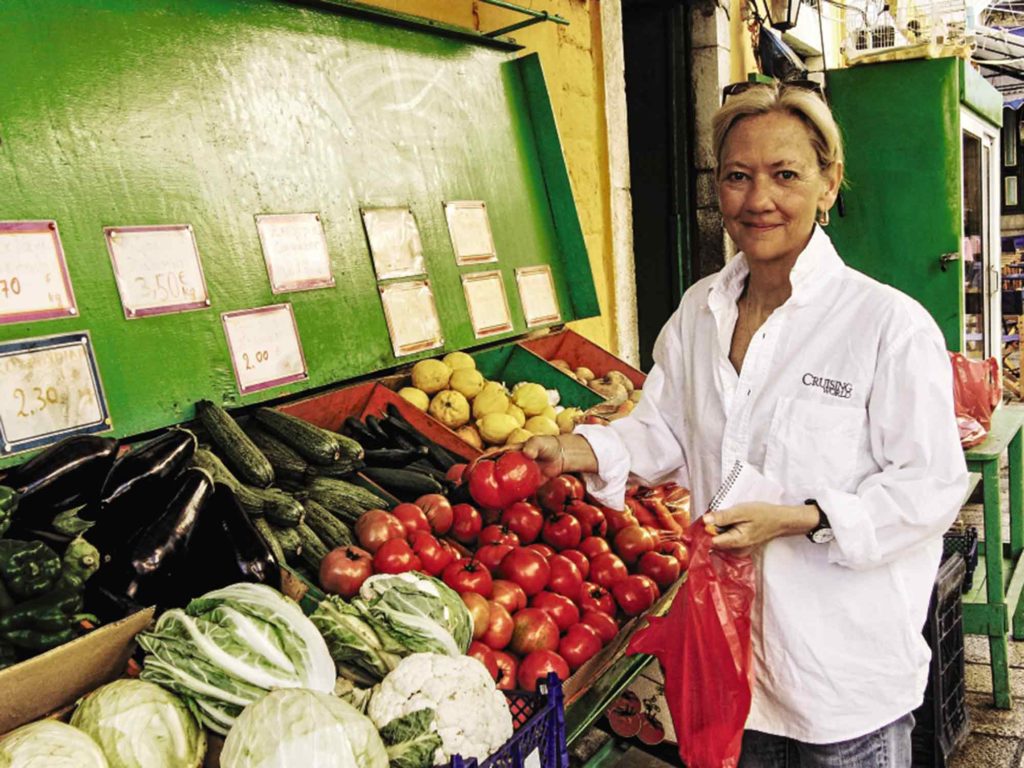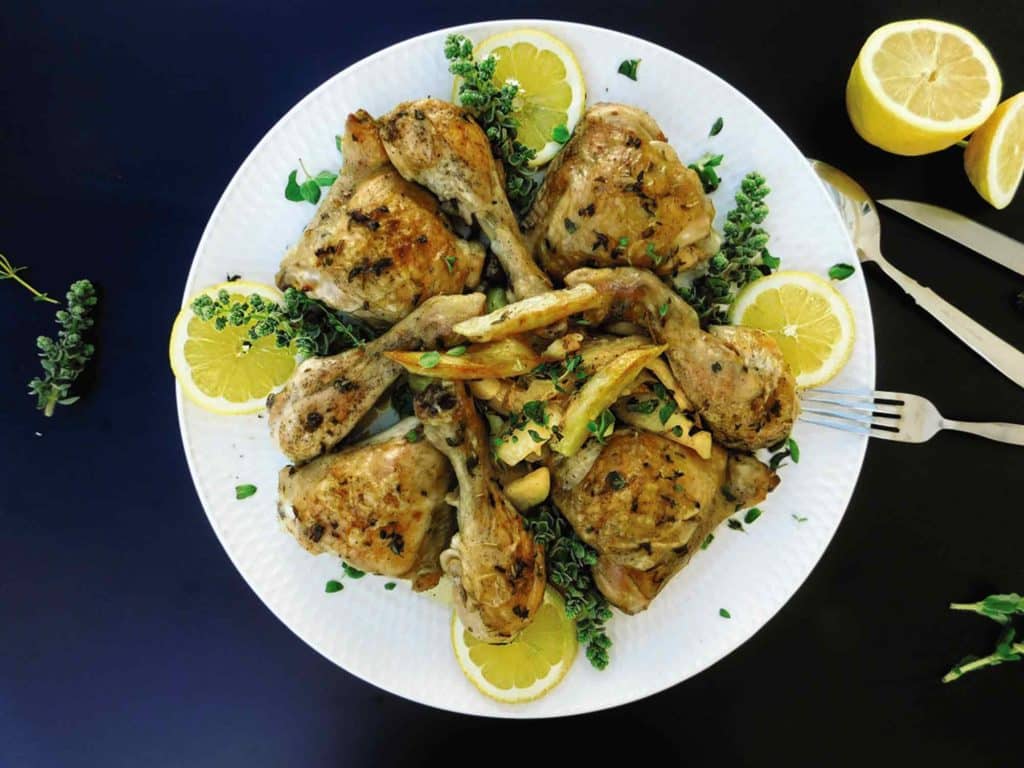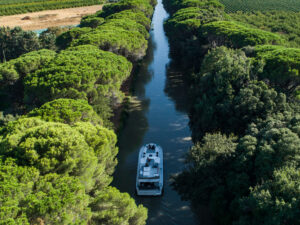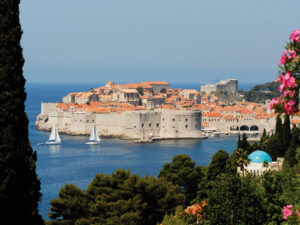
It was Lucas, age 8, who spoke first.
“Whoa!” he hollered. “This chicken is, like, totally good!”
The words drifted down the companionway and directly into my ears, which, along with the rest of me, were standing at the sink engaged in scrubbing a seriously crusty pan. We were in Greece’s Saronic Islands after a morning of sailing, anchored in a quiet spot for swimming and lunch aboard Stressbuster, our Greek-designed Atlantic 70 cutter. Our charter guests that week were a delightfully down-to-earth family of four from Connecticut.
It’s not that I make a habit of eavesdropping, exactly. But I must confess, I dolisten to gauge guests’ reactions to the lunches I serve on board. Sounds of satisfaction—or complete silence except for the clinking of utensils against plates, followed by low murmurs of “yum” or “this is delicious”—are always music to my ears.
Suddenly (still not eavesdropping), I realized that Luc’s 6-year-old sister, Lyra, was ominously silent. I sneaked a peek up the companionway, dreading the “I’m so not happy” look that often precedes a kid meltdown. Instead, I saw her fully engaged in hands-on chowing down a chicken leg, face over plate, chicken bits on face, fork asunder. All good.
As crew and cook aboard Stressbuster, I try to make one daily meal that will please everyone. This can be tricky, even with grown-ups (everybody’s a kid at heart), but it is especially so when we have young sailors aboard.
It’s a rare kid who will eat anything and everything. We’ve had finicky eaters, including one who’d eat only spaghetti with butter; another, only chicken nuggets; yet another, only Nutella on fresh bread or fruit, for the entire week. We’ve had trend eaters who left me wondering, How do kids decide to become macrobiotic vegans at age 12? Far more frequently, we have kids who are just missing familiar comfort foods from home who ask, “Do you know how to make peanut butter and jelly?” Yes, you bet I do!

Ever since my Greek husband, Kostas, and I began charters on our boat 20-plus years ago, I’ve adapted Greek recipes to make them more boat-friendly and added my own touches. That day’s lunch, Greek chicken lemonata, was one of my first attempts. Though I’d served it to a few adults, always receiving rave reviews and requests for the recipe, I had yet to serve it to my most discerning diners: the kids.
In Greece, chicken lemonata is often braised, either in a large stewpot on the stovetop, or covered with foil in the oven with lotsofwater added. Since I usually cook lunch underway, weather permitting, neither was a terrific option. Oven-braising requires frequent checks and replenishing of pan liquid, not to mention yielding mushy chicken and potatoes. And a large stewpot on even a gimbaled stovetop underway is a no-go. (We have a stove safety rail, as well as stainless-steel pot clamps, but when it comes to large pots, both fail spectacularly.) I needed to adapt this dish for safe, hassle-free one-pan cooking underway, in the oven, with its door locked.
It’s a rare kid who will eat anything and everything. We’ve had finicky eaters, including one who’d eat only spaghetti with butter.
Oregano is a worshiped herb in Greek cuisine, a fact that is not surprising because the stuff grows in Greece with almost supernatural abundance, even in the wild. The Greeks use it in, well, almost everything. Fresh herbs always trump dried, if you can get them—and I had them, from our home herb garden. In addition to the requisite oregano, I added sage, rosemary, thyme and more garlic. For the lemon sauce, I whisked olive oil together with lemon juice and a pinch of salt. No water. It worked.
After lunch that day, with the dishes stowed and galley cleaned, I rejoined the crew on deck. As we sailed downwind toward the next island, the kids’ mom, Liz, leaned over and whispered, “Lynda, the kids have made a wish: for that lemon chicken one more time before we leave. Do you think that’s even possible?”
You can guess what my answer was. Not only did my chicken pass the kid test, but I also got to grant two kids’ wishes in the bargain.
I’m totally good with that.
Roasted Greek Chicken Lemonata

- 4 bone-in, skin-on chicken thighs
- 4 bone-in, skin-on chicken legs
- 11/4 to 11/2 cups olive oil
- Juice of 1/2 medium lemon (about 1 Tbsp., or to taste)
- Pinch of salt
- 2 tsp. each, chopped: fresh sage, rosemary, thyme, oregano; or, 1 heaping tsp. each, dried
- 3-4 large cloves garlic, minced
- 4 medium potatoes
- Salt and pepper, to taste
Serves 4
Preheat the oven to 400 degrees Fahrenheit. Rub the chicken pieces with some of the olive oil, salt and pepper, and arrange in a lightly oiled large baking pan, leaving space for potatoes in between. (If your boat oven lacks a top heating element, then lightly brown the chicken in a little olive oil first.)
In a large measuring cup, whisk together most of the remaining olive oil, all of the lemon juice, and some salt until emulsified and blended. Add the chopped herbs and minced garlic. Stir together with a fork (garlic and herbs will gum up a whisk). Set aside to let the flavors blend.
Cut potatoes into eighths lengthwise. Place them in a large bowl. Add a bit of salt and pepper and a swirl of olive oil, and toss with your hands to coat.
Wedge the potatoes around and under the chicken in the pan, making sure the potatoes are touching the bottom or sides. Pour the olive-oil/lemon mixture over everything, distributing the sauce, herbs and garlic evenly.
Bake for about 1 hour, uncovered, basting once halfway through, until the chicken and potatoes are done. The internal temperature of the chicken should be at least 165 to 175 degrees Fahrenheit, and the potatoes should be soft inside.
To serve, arrange the chicken on a large serving platter, with the potatoes in the middle. Drizzle pan juices over it all. Garnish with sprigs of fresh herbs and lemon slices.
- Prep time: 1 hour, 15 minutes
- Difficulty: Easy
- Can be made: Underway or At Anchor








